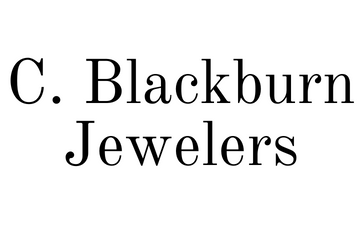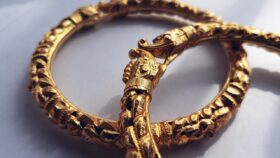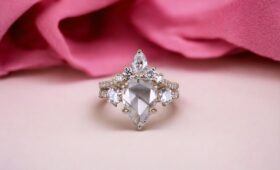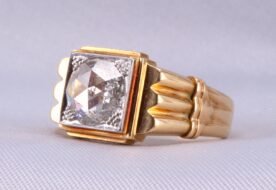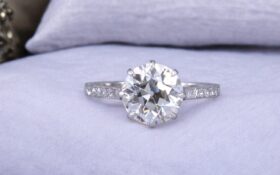
11 Nov History of Rose Gold Jewelry & Rings
At C. Blackburn Jewelers of La Jolla, we love rose gold jewelry. We buy vintage and antique rose gold jewelry to feature in our showcases, and our owner Carl Blackburn creates custom jewelry in rose gold, such as the Diamond and Pear-shaped Morganite ring seen above.
While rose gold jewelry rises and falls in popularity, it never goes out of style. The metal’s soft, rose hue complements both the fashion and skin of the wearer, which is why you’ll find it used in engagement rings, drop earrings, cufflinks, and more.
What is Rose Gold?
Before buying rose gold jewelry, it’s probably useful to have a good idea what this gorgeous metal actually is. To understand why rose gold even exists, we’ll need to take a quick look at gold itself.
Pure gold is bright yellow. It has been a highly coveted metal for millennia. But in its pure state, gold is actually quite soft, and not suitable for use in jewelry making. In order to make gold more durable, the precious metal is combined, or alloyed, with other metals. Typically, gold is mixed with zinc, nickel, and copper, with these mixtures resulting in gold of varying purity, hardness, and color.
When pure gold is alloyed with nickel and subsequently rhodium plated, the result is white gold. Rose gold’s color is due to a copper alloy being mixed with pure yellow gold. The greater amount of copper alloy in your gold jewelry, the redder it will appear. 18k rose gold is typically 75% gold and 22.5% copper, and 2.75% silver. Variations of rose gold include 18k red gold (75% gold, 25% copper), and 18k pink gold (75% gold, 20% copper, 5% silver).
One benefit of using rose gold in jewelry (in addition to its color) is that it is more durable than yellow gold and white gold (which requires rhodium plating for added durability). Also, rose gold turns out to be surprisingly affordable.

History of Rose Gold Jewelry
Rose gold was first seen in late 19th century Imperial Russia, and as a result of its popularity there, the new alloy earned the now forgotten name, “Russian Gold.” Though the exact originator is unknown, we do know that famed jeweler to the czars, Carl Fabergé, was one of the first great jewelers to use rose gold extensively in his work, especially in his famous Fabergé eggs. His most expensive commission, the renowned “Moscow Kremlin” egg (a replica of the Spasskaya Tower that overlooks Red Square) features spectacularly ornate work in rose gold.
The new alloy went on to have a period of popularity during the mid Victorian years, and a long cycle of falling in and out of favor was established for the precious metal. Despite a favored place in the elaborate jewelry of the Victorian era, rose gold’s popularity waned at the turn of the century, as the Edwardian era’s fascination with the new “white” jewelry in platinum and silver grew.
Rose Gold’s Golden Era: The 1920s
By the 1920s, the vividly colorful and creative jewelry of the art deco era came into fashion, and rose gold was perfectly suited to the aesthetic of the day. Characterized by excess and opulent lifestyles, the “Roaring 20s” saw a return to lavish fashions and luxuriously elegant jewelry.
Creative designers were inspired by vivid colors, and many began to use the ‘forgotten’ rose gold to add femininity and warmth to their designs. Famed jewelry house Cartier was a leader in the trend, incorporating the pinkish metal into many of their jewelry designs.

Trinity De Cartier
Of particular note during this period was Cartier’s introduction of the now iconic “Trinity Ring.” Commissioned privately by the French artist, writer, and filmmaker Jean Cocteau, the Trinity ring featured interlaced bands of yellow, white, and rose gold in a moveable stack that Cocteau famously wore on his lift pinky. The ring proved a favorite of both women and men, and was also famously worn by the actor Gary Cooper. So popular was the design that variations of it are still being created by Cartier today.
In and out of favor
Despite rose gold’s popularity in the 1920s, the vivid colors and highly imaginative jewelry of the art deco era gave way to more reserved, monochromatic jewelry stylings in the 1930s. After the Wall Street crash in 1929, rose gold fell out of favor as designers flocked to the icy white color schemes of platinum and diamonds that seemed more in keeping with the fiscal austerity of the times. Interestingly, it was the jewelry industry’s reliance on the precious metal platinum that ultimately brought rose gold back to the forefront of jewelry design.
With the outbreak of World War II, platinum was needed for a variety of military applications, and suddenly the precious metal was considered a strategic asset vital to the war effort. Platinum’s use in jewelry making was greatly restricted, and even prohibited in some countries. As a result of platinum’s scarcity, yellow and rose gold came back in fashion as the precious metals of choice, and their wide use during the war helped define the jewelry of the day.
Also known as “retro style,” these bold designs featured oversized, three dimensional pieces in yellow, rose, and even green gold. Bulky bracelets, extravagant brooches, and cocktail rings with oversized semi-precious stones set in rose gold were typical of the era. While platinum is once again widely used today, the femininity and warmth of rose gold has never really fallen completely out of style since before the war.

Rose Gold Jewelry Today
During the black and white minimalism of the 1990s, rose gold may have faded from the spotlight a bit, but its popularity came roaring back with the beginning of the new century, for a number of reasons. First, there was a pronounced turn away from the coldly chic, almost clinical looks of the 90s in favor of a more feminine, colorful look.
For the contemporary woman looking to blend the modern with the traditional, rose gold proves to uniquely marry the two, and many high fashion designers, from Cartier and Piaget to Van Cleef & Arpels are once again embracing rose gold. The use of the softly hued metal by such luminaries has already begun to ‘trickle down’ to jewelry designers at all levels.
Another theory about the recent resurgence of rose gold is that the metal’s slightly pinkish hue compliments nearly any skin tone. The warmth of rose gold can highlight subtle, even youthful looking blush notes in nearly any skin type. And in a world now dominated by excessive “bling,” the understated warmth of rose gold enhances both neutral tones and and embellishes more frilly, feminine styles.
Finally, rose gold has a timeless, vintage quality that appeals to many. While the styles may be contemporary, the metal itself hearkens back in time with its softly understated elegance.
Whatever the reason for its resurgence, the trend toward rose gold has spread well beyond jewelry. The Apple iPhone is available in rose gold, as is a satchel by Alexander Wang. You can even get ‘rose gold’ lip gloss, and Birkenstock’s classic Arizona sandal is available in ‘rose gold’ as well.
As surely as rose gold saturates the culture once again, many will continue to be drawn to the recently ‘rediscovered’ metal, with its soft color and timeless elegance.
Rose Gold Custom Engagement Rings
Are you looking for a San Diego jewelry designer who can create a custom engagement ring in rose gold? Contact Carl Blackburn at C. Blackburn Jewelers of La Jolla. He’ll be happy to discuss with you the ring, earrings, necklace, or cufflinks that you would like designed in rose gold. Visit our La Jolla jewelry store also to see what rose gold estate jewelry we may have in our showcases.
Call us at 619-723-8589 or send us an email via the contact form below.
